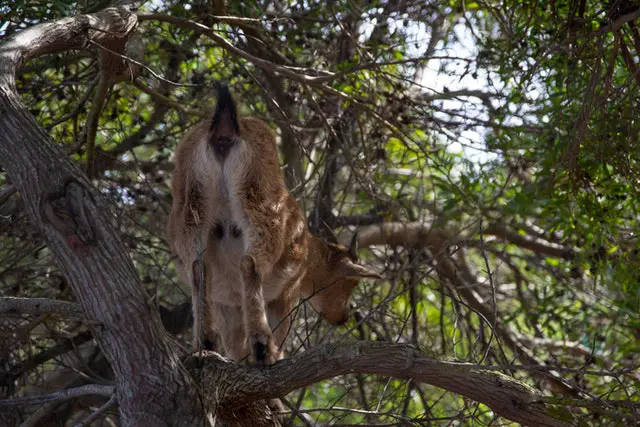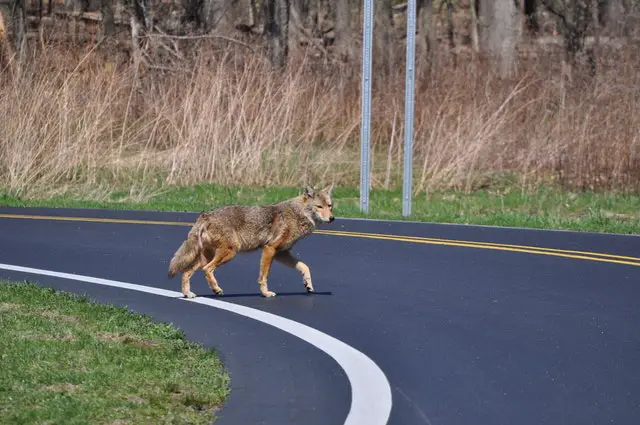Coyotes are wild canines closely related to wolves, with similar characteristics and body types. Few animals, like coyotes, can successfully adapt to their surroundings and use them to their advantage. While they are fast, agile, and ferocious, many people wonder, can coyotes climb trees?
Coyotes can not climb trees in the same way felines do. They cannot wrap their limbs around tree trunks, and their claws are not sharp enough to dig into the wood quick enough to latch on.
While coyotes can’t climb trees per se, they can make their way up them with the right incentives. Let’s take a closer look into the composition of the coyote body and whether or you not you should worry about them nesting in the trees sitting in your backyard.
Can Coyotes Climb Trees?

In the typical sense of tree climbing, no, coyotes do not have the physical makeup required to latch onto and ascend into a tree like a cat, bear, or raccoon. Their claws are not sharp enough to quickly and accurately attach to the bark or wood to get a good enough grip to support their weight.
How Do Coyotes Get Up into Trees?
Just because we said coyotes could not climb trees doesn’t mean they are incapable of getting up into them. If you have seen coyotes perched on a branch or chasing prey up a large tree, you are probably sitting there right now, confused by our previous statement.
Coyotes are driven and, most of the time, hungry. If the only food in the area is hiding out in a tree, they can find ways to reach them.
As long as the tree offers low branches, or it is growing at an angle and can be walked across rather than climbed up, a coyote can make its way up into the foliage and after whatever animal it plans on calling dinner.
Why Do Coyotes Climb Trees?
Aside from hunting for food, as mentioned above, there are other reasons you might see a coyote sitting on a tree branch perched above the world.
1. Overcoming Obstacles
Coyotes are known for being smart, cunning creatures and will find ways to get what they want if they are determined enough.
If a coyote is chasing prey or senses easily accessible meals behind a fence or barrier (i.e., chickens in a coop, exposed garbage bins, etc.), they are more than capable of devising a plan to overcome anything in their way.
If there is a tree nearby, a coyote can scale it just enough to utilize the branches, making themselves a bridge from one side of an obstacle to another.
For all you farmers out there, putting up a fence to keep coyotes from eating your livestock is a good start, but it isn’t a full-proof way to protect your animals.
2. Hiding From Other Animals

It isn’t too often you find a coyote running from a bigger, faster predator; nevertheless, it does happen. You might see a picture of a coyote on a large branch or watch one scale a tree on a trail cam, trying to escape an immediate threat.
Because coyotes can run as fast as 40mph and are capable of walking on their tip toes to avoid threats or danger, even from hunters, it is very rare are you will find one hanging out in a tree just to hide.
3. Can Coyotes Climb Fences?
Coyotes may not have the ability to climb trees and other verticle obstacles very well, but they are great at jumping, with the ability to leap up to eight feet into the air and use their hind legs to scale over things such as fences, even when there isn’t a tree around to use as assistance.
Like with low-hanging tree branches, coyotes can jump just about any size fence as long as they can reach the top of it with their forearms and use their hind legs to push off of surfaces and catapult themselves over the top.
4. How Can You Stop Coyotes From Climbing?

If you have pets and children that pay in your backyard or are sick of cleaning up the messes these creatures cause went they get into your garbage cans, gardens, or garages, there are ways to keep them from climbing trees, fences, and other obstacles that offer them access to your home.
- Here are a few great options to reduce coyote activity near your home.
- Build a fence and add a rolling bar or barbed wire to the top
- Install a motion-sensing deterrent (motion sensor lights and sounds)
- Cut all low-hanging branches from trees up to five feet
The best way to keep wildlife out of your yard is to eliminate as much “food” as possible. Keep lids on your garbage cans, clean up after backyard BBQs and parties, and lock up your chickens and other barn animals when you are not able to keep a close eye on them.
Also see: Can Deer Eat Bread
Summing Things Up
Although coyotes can’t climb trees the same way felines can, they do have the ability to get themselves up and into trees with the right amount of determination and drive, thanks to strong hind legs, incredible agility, and high intelligence.
Coyotes will go to any length to get their next meal, protect their young, or avoid danger, making trees an excellent tool for any canine living in the wild.
Frequently Asked Questions
What Times Are Coyotes Likely to Climb Trees and Fences?
Coyotes are nocturnal hunters and can most likely be seen scaling trees and fences during the dawn and dusk hours. This is when they are most likely looking for food and shelter.
With that said, coyotes can be seen roaming around pretty much any time of the day, between dawn and dusk. Throughout the night, these creatures prefer to stay and rest in packs.
Can Coyotes Keep Their Balance on Small Branches?
Coyotes are flexible, stealthy, and smart; they can twist and turn their bodies, even mid-air, to get where they are going; this includes climbing on small branches and thin fence railings. Coyotes are very good at balancing and can keep themselves sturdy even at high speeds.
On average, an adult coyote weighs around 30 pounds, making them light enough to stand on smaller branches without breaking them and falling off.
Do Coyotes Climb Trees to Search for Prey?
This question is up for debate. While coyotes may use the advantage of using “above ground” views to track pretty, they really don’t need to.
Coyotes have extremely impressive eyesight that helps them see other animals and even danger from a far distance away. So, they might use this method in heavy vegetative areas, to see in tall grasses and dense shrubbery, but more often than not, this isn’t going to be the case.

Hey, I’m Lisa and I’ve been an avid gardener for over 30 years. I love writing, talking and living in the garden! Feel free to connect with me on my socials below

